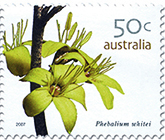|
|
|
Like the continent’s distinctive fauna, the flora of Australia has evolved in isolation for 50 million years, and many plants and flowers are found nowhere else on earth. In 2007, Australia Post issued a four stamp definitive series on Australian Wildflowers - the third issue in the Australian Wildflower series.
One of the featured flowers in this issue was Phebalium whitei, a small shrub that is only found within and around Girraween National Park. Phebalium whitei is listed as a vulnerable species within Australia under the Environment Protection and Biodiversity Conservation Act 1999.
|
|

|
|
Images of the 2007 "Australian Wildflowers" stamp issue (stamps, First Day Cover and Stamp Pack) and copyrighted text from the 2007 "Stamp Bulletin" have been reproduced with permission from Australia Post.
A special thank you goes to Richard Breckon from the Australia Post Philatelic Archives for his assistance.
Stamps are shown larger than actual size.

|
|
Tasmanian Christmas Bell (Blandfordia punicea)
As its name suggests, the Tasmanian Christmas Bell is endemic to Tasmania. Its leaves are narrow and linear to one metre in length and one centimetre in width. It flowers in summer, with tubular, waxy clusters at the end of a stout stem up to one metre in length. Its flowers are up to four centimetres long and two centimetres wide, and it prefers moist acid soils in heathlands.
|

|
|
Green Spider Flower (Grevillea mucronulata)
The Green Spider Flower is widespread from coast to mountains, in open forest and woodlands in New South Wales. Flowering in winter and spring, it is a spreading shrub to 2.5 metres high with reddish branches. The flowers are green and in spider-like racemes about five centimetres across. Each flower has a hairy, dark purplish-red style to two centimetres long with a green tip.
|

|
|
Sturt's Desert Rose (Gossypium sturtianum)
This flower is widespread in the dry inland regions of mainland Australia. Flowering most of the year, it is found mainly in rocky gullies but also on sand plains. The hibiscus-like flower is a delicate lilac with a red throat spot. The bush is an erect, open shrub growing up to two metres high and its hairless, blue-green leaves are scented when crushed. The plants are perennial and live for about 10 years. Sturt's Desert Rose is the floral emblem of the Northern Territory.
|

|
|
Phebalium whitei
There is no common name for this yellow-flowering shrub which is restricted to the granite outcrops of border ranges in Queensland. This spreading and open shrub reaches one metre in height and flowers in spring. It has brownish branchlets which bear conspicuous clusters of one to six flowers and rusty-coloured buds.
(Since this text was printed in the Stamp Bulletin, the plant has aquired the common name of White's Phebalium.)
|
- Issue date: 13 February 2007
- FDI withdrawal date: 13 March 2007
- Denominations: Four x 50c
- Design: Lynette Traynor, Australia Post Design Studio
- Printer: SEP Sprint & Pemara
- Paper (gummed): Tullis Russell
- Paper (self-adhesive): B90, B100 & KV75-40080-WLK1
- Printing process: Lithography
- Stamp size: 30mm x 25mm
- Perforations: 14 X 14.4
- Sheet layout: 50
- Special feature: None
- National postmark: GPO Hobart TAS 7000
The issue includes a first day cover and stamp pack (see below), booklets of 10 and 20 x 50c stamps, and rolls of 100 and 200 x 50c stamps. The maxicards of the issue show the unique beauty of these stunning Australian wildflowers.

First Day Cover

Stamp Pack cover
|

Stamp Pack interior
|
|
|

